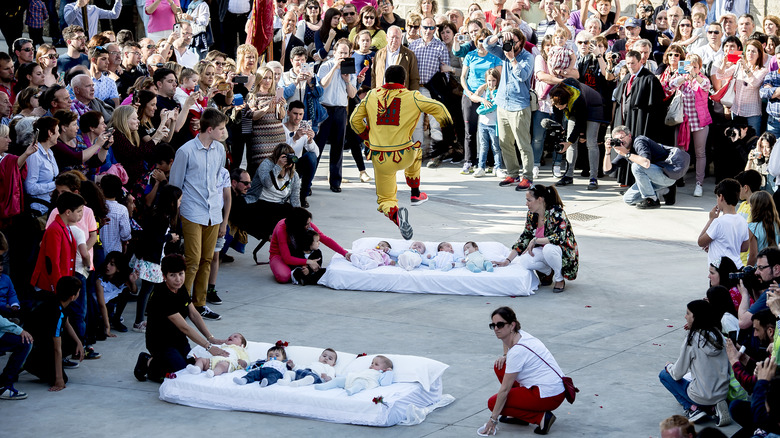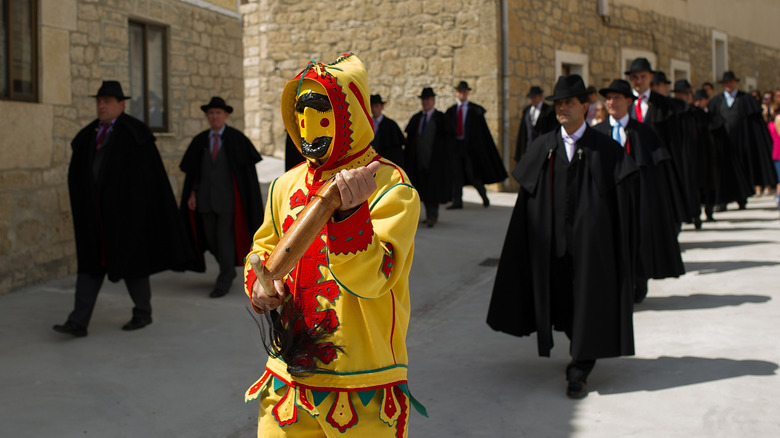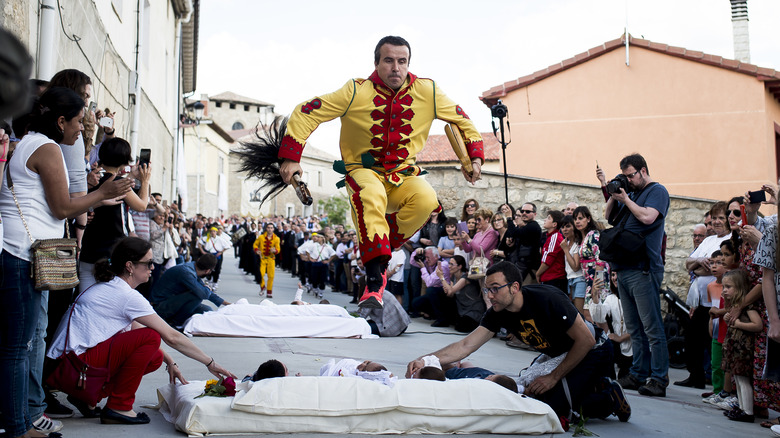The Wild History Of The Baby Jumping Festival
Spain has given birth to some rather colorful religious and cultural festivals. For example, prior to 1926, few outside of the Iberian Peninsula had heard of the town of Pamplona and its annual San Fermin Festival, which culminates in the Running of the Bulls. As The Tennessean reports, writer Ernest Hemingway wrote of the festival in his blockbuster book, "The Sun Also Rises," and nowadays it's a huge tourist attraction, despite concerns about animal abuse. Similarly, so popular is Buñol's La Tomatina, during which revelers throw tomatoes at each other, that the city is forced to limit the number of tickets sold to 20,000, according to The Travel.
However, one Spanish festival doesn't appear to have gained such widespread international interest. That could have something to do with the fact that the participants in the festival of El Salto del Colacho, who lay in the street while masked men dressed as the devil ceremonially jump over them, don't have the option to opt-out. That's because they're babies.
Paganism and Christianity Intersect
"El Salto del Colacho" or the "Devil Jump", takes place in Castrillo de Murcia, Spain, and dates back to 1620, according to Insider. Some historians believe that, like other European Christian traditions, is actually a mix of pagan and Christian rituals, possibly having originated as a fertility ritual (via National Geographic).
The Catholic Brotherhood of the Sacred Sacrament of Minerva puts on the weeklong festival in the small town to mark the Feast of Corpus Christi, according to Culture Trip. During the festival, men dressed in yellow and red play the role of "colachos," or "devils," and antagonize the townsfolk, beating them with a horse tail attached to a stick. Then, the "atabalero," dressed in black, ceremonially drive the devils out of town, according to National Geographic, a sort of metaphor for victory over evil through Christianity.
The culmination of the festival is the jump, during which babies born in the previous year are lain on mattresses, and the devils jump over them. It's viewed as something akin to a baptism, and the "devils" figuratively absorb the infants' original sin. Following, the tots are sprinkled with rose petals and given back to their (presumably relieved) parents.
The Catholic Church Isn't On Board
You might think that placing your babies on the street to be jumped over by costumed men is an invitation to gruesome injury, but National Geographic claims that there have been no reports of babies being maimed or killed in the festival. In 400 years, that's quite a record. Further still, according to Religion News, the only reported injuries have been to the colachos themselves, some of whom have pulled hamstrings jumping over the babies. One Colacho, dressed in 17th-century garb, but for his 21st-century sneakers, told Lonely Planet that he practices by laying pillows in the street or in his garage, and jumping over them.
Meanwhile, the Catholic Church isn't really feeling it, according to All That Is Interesting, not because it exposes babies to injury, but because of the theological optics. Specifically, back in 2013, then-Pope Benedict asked the region's priests to dial back the connection between jumping and baptism, because the Church holds that the only true baptism occurs through water baptism.


